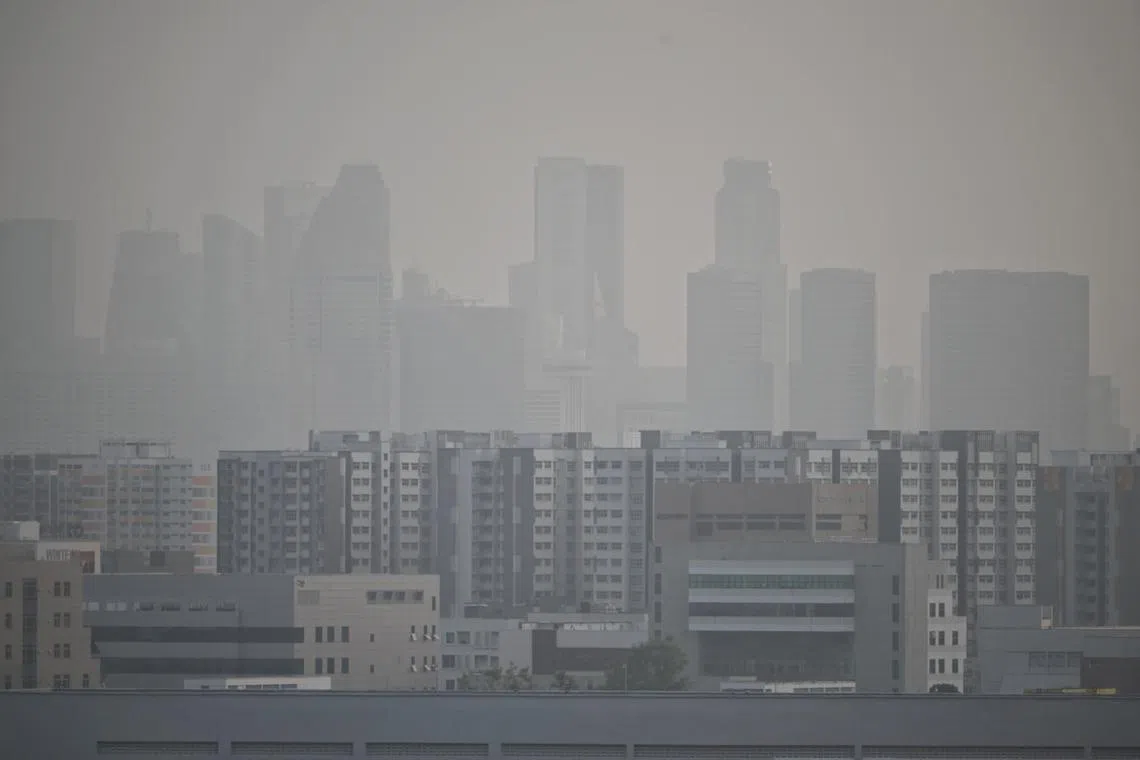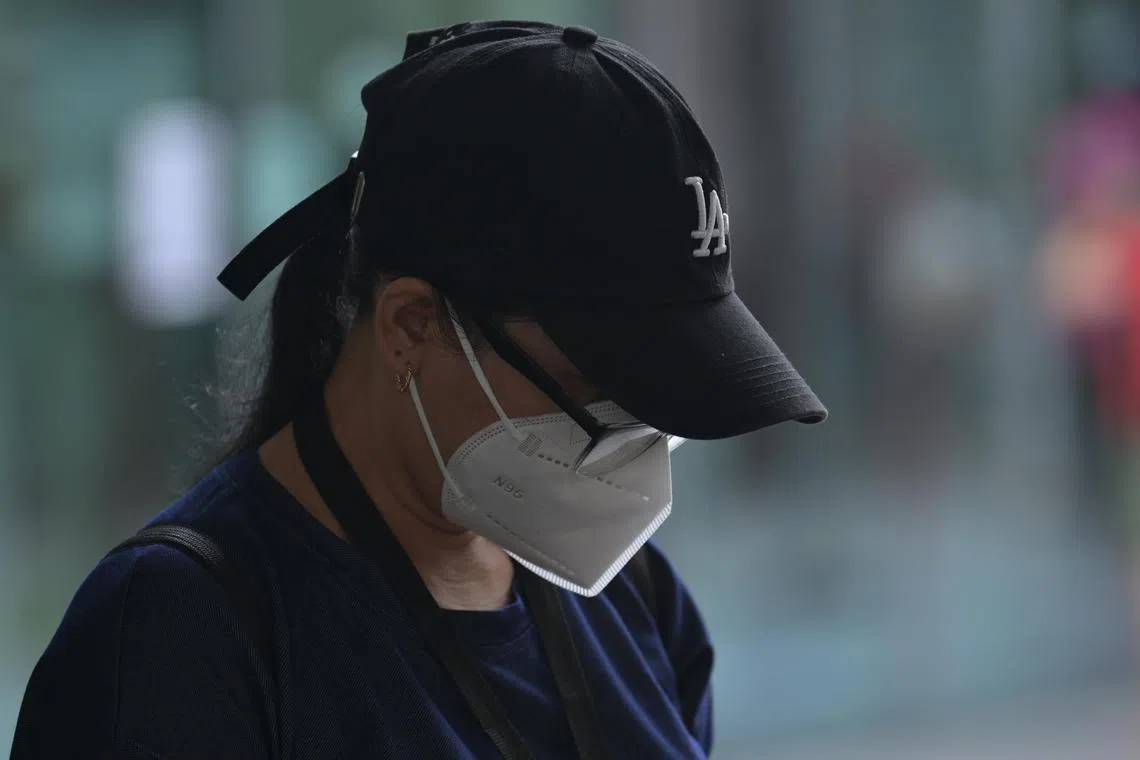The Life List: Five ways to protect yourself when the haze hits
Sign up now: Get ST's newsletters delivered to your inbox

Haze shrouding Singapore's skyline at 6.30pm on Oct 8.
ST PHOTO: ARIFFIN JAMAR
Follow topic:
SINGAPORE –Haze season is here and there are certain groups of people who should take extra care against the polluted air.
Last Saturday, for the first time since 2019, the 24-hour Pollutant Standards Index (PSI) entered the “unhealthy” range,
Children, pregnant women as well as the elderly with chronic heart and lung conditions are among those who are more vulnerable to the effects of haze, say doctors.
Dr Lim Hui Fang, a respiratory specialist at The Respiratory Practice, says: “Children have smaller airways and faster respiratory rates, which mean they breathe in more haze particles for their body size. As for the elderly, their bodies are less able to compensate or clear the pollutants they inhale. This puts them at higher risk of falling ill.”
Those who have just recovered from Covid-19 and are experiencing conditions such as bronchitis or sinusitis as a result are also at higher risk of experiencing the adverse effects of inhaling haze particles, notes Dr Lim.
In addition, people with allergies and respiratory issues such as asthma and chronic obstructive pulmonary disease should take extra care, highlights Dr Leong Choon Kit, a family physician at Mission Medical Clinic.
“People affected by the haze are more at risk of developing symptoms such as conjunctivitis, sore throat, cough, shortness of breath and a feeling of tiredness and weakness,” says Dr Leong.
He advises those who feel unwell during haze episodes to see a doctor.
Follow these tips to protect yourself against the haze.
1. Follow PSI readings
Dr Leong says it is important to check the PSI daily and understand what it means.
PSI is calculated based on a 24-hour average of PM2.5 concentration levels, among other pollutants. PM2.5 is the dominant pollutant during haze episodes.
The 24-hour PSI is based on readings taken over the past 24 hours, and the one-hour PM2.5 concentration reading is an indicative measure of the current air quality. The health advisory in Singapore is based on the 24-hour PSI.
If you are planning for activities the next day, refer to the 24-hour PSI forecast and accompanying health advisory.
If you are planning for immediate activities, such as deciding whether to go for a walk or jog, refer to the one-hour PM2.5 concentration reading.
There are four bands on the PM2.5 concentration scale: 0 to 55 for normal, 56 to 150 for elevated, 151 to 250 for high and 251 and above for very high readings.
During periods of transboundary haze, the forecast range of the 24-hour PSI, as well as the National Environment Agency’s (NEA) daily haze advisory, will be available on NEA’s website ( www.nea.gov.sg www.haze.gov.sg
2. Mask up

As a guide, those who are healthy and will be outdoors for a few hours should wear an N95 mask if the PSI is 300 and above.
ST PHOTO: NG SOR LUAN
An N95 mask can help to filter out fine haze particles, but not surgical or cloth masks, says Dr Lim.
As a guide, those who are healthy and will be outdoors for a few hours should wear an N95 mask if the PSI is 300 and above, according to a haze health advisory by the Ministry of Health (MOH).
The elderly, pregnant women and people with chronic lung and heart disease should put on an N95 mask if the PSI is 200 and above.
As the use of N95 masks requires greater effort to breathe, people who have difficulty breathing at rest or on exertion should consult their doctor as to whether they should use one, according to the MOH advisory.
According to NEA, N95 masks are not needed for short exposures, such as commuting from home to school or work, or travelling from a bus stop to a mall. N95 masks are also not needed in an indoor environment.
For the mask to be effective, it must be appropriately sized, covering the nose and mouth comfortably to prevent any leaks.
3. Keep the air clean
To reduce the exposure to haze particles indoors, Dr Lim advises closing the doors and windows and switching on the fan or air-conditioner. Consider using an air purifier to reduce the particle level in the air, she adds.
When cleaning, she recommends mopping or wiping instead of vacuuming, so as not to stir up the settled dust.
4. Stay hydrated

Drinking plenty of water may help those with symptoms such as a dry or itchy throat.
PHOTO: ST FILE
Drinking plenty of water may help those with symptoms such as a dry or itchy throat brought about by the haze, says Dr Leong.
5. Avoid strenuous activities
Haze particles can affect the heart and lungs, especially in those who have chronic conditions such as asthma, chronic obstructive pulmonary disease or heart failure, say doctors.
Dr Leong says such groups of people should avoid prolonged or strenuous outdoor physical exertion when the 24-hour PSI reaches unhealthy levels of 101 and above.
In such a case, healthy people should reduce prolonged or strenuous outdoor physical exertion, while the elderly, pregnant women and children should minimise such activity.
This article has been edited for clarity.


